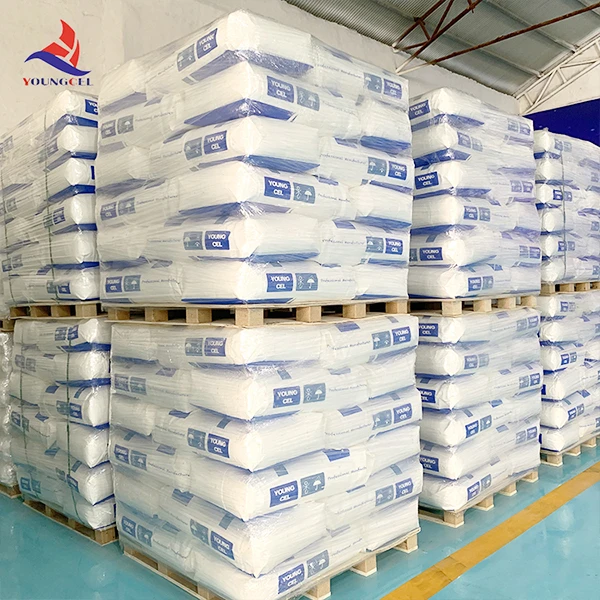The Evolution of HPMC Manufacturing A Comprehensive Overview
Hydroxypropyl Methylcellulose (HPMC) has gained significant traction in various industries, including pharmaceuticals, food, construction, and personal care. As a versatile cellulose ether, HPMC plays a crucial role as a thickener, binder, film-former, and emulsifier. This article aims to delve into the manufacturing process of HPMC, its applications, and its impact on modern industries.
Understanding HPMC and Its Properties
HPMC is a semi-synthetic derivative of cellulose, which is primarily derived from natural plant sources. Its unique properties, such as water solubility, thermal gelation, and film-forming ability, make it an essential ingredient in many formulations. HPMC is non-toxic, biodegradable, and versatile, characteristics that have led to its widespread acceptance in numerous applications.
The Manufacturing Process of HPMC
The production of HPMC involves several critical steps
1. Cellulose Extraction The first step in HPMC production is the extraction of cellulose. This is typically done from wood pulp or cotton linters. Through chemical treatment, cellulose fibers are separated from lignin, hemicellulose, and other impurities.
2. Etherification Reaction Once purified cellulose is obtained, it undergoes etherification, where propylene oxide and methyl chloride are introduced. This reaction modifies the cellulose structure, resulting in the formation of hydroxypropyl and methyl ether groups. The degree of substitution, which refers to the number of substituted hydroxyl groups, is carefully controlled to tailor the properties of the final product.
3. Purification and Drying After the etherification process, the HPMC solution is purified to remove any unreacted materials or by-products. This is often followed by drying the product to form a fine powder. The drying process must be controlled to prevent degradation of the cellulose structure, ensuring that the final product retains its desired properties.
4. Quality Control Quality assurance is a pivotal part of HPMC manufacturing. Rigorous testing is conducted to confirm that the product meets industry standards and specifications regarding viscosity, solubility, and other performance characteristics before it is released to the market.
Applications of HPMC
hpmc manufactur

The applications of HPMC are extensive
- Pharmaceuticals In the pharmaceutical industry, HPMC serves as a binding agent in tablet formulations, ensuring that active ingredients are distributed evenly and released properly in the digestive system. It is also used in controlled-release medications, where it helps regulate the release rate of the active ingredients.
- Food Industry In food applications, HPMC is utilized as a thickener and emulsifier. It enhances the texture of various food products, such as sauces, dressings, and bakery items. Additionally, it acts as a stabilizer in low-fat and gluten-free products, helping to improve their mouthfeel and overall quality.
- Construction In the construction industry, HPMC is a vital ingredient in cementitious materials, such as mortars and adhesives. It improves water retention, workability, and adherence, making it easier to apply and enhancing the performance of building materials.
- Personal Care Products HPMC is also widely used in cosmetics and personal care items. It acts as a stabilizer in creams and lotions, improving their texture and skin-feel. Additionally, it functions as a film-former in various products, contributing to the longevity and effectiveness of formulations.
The Future of HPMC Manufacturing
As industries strive towards sustainability, the demand for bio-based and eco-friendly materials continues to rise. HPMC, being derived from natural cellulose, is well-positioned in this context. Innovations in the manufacturing process, such as enzymatic treatments and green solvents, are being explored to enhance the efficiency and environmental footprint of HPMC production.
Moreover, ongoing research into the properties and potential applications of HPMC is expected to open new avenues in various sectors, further solidifying its role as a vital ingredient in numerous formulations.
Conclusion
In conclusion, the manufacturing of Hydroxypropyl Methylcellulose is a sophisticated process that plays a crucial role in multiple industries. With its unique properties and versatility, HPMC continues to be a valuable ingredient in pharmaceuticals, food products, construction materials, and personal care items. As the industry progresses, HPMC will undoubtedly evolve further, adapting to meet the changing demands of sustainability and performance in an ever-competitive market.
-
Rdp Powder: Key Considerations for Wholesalers in the Building Materials IndustryNewsJul.08,2025
-
Key Considerations for Wholesalers: Navigating the World of Hpmc - Based ProductsNewsJul.08,2025
-
Hpmc Detergent: Key Considerations for WholesalersNewsJul.08,2025
-
Key Considerations for Wholesalers: China Hpmc For Tile Adhesive, Coating Additives, Concrete Additives, and MoreNewsJul.08,2025
-
Crucial Considerations for Wholesalers: Navigating the World of Construction MaterialsNewsJul.08,2025
-
Key Considerations for Wholesalers Sourcing Additive For Cement, Additive For Concrete, Additive For Putty from Additive Manufacturer Shijiazhuang Gaocheng District Yongfeng Cellulose Co., Ltd.NewsJul.08,2025




